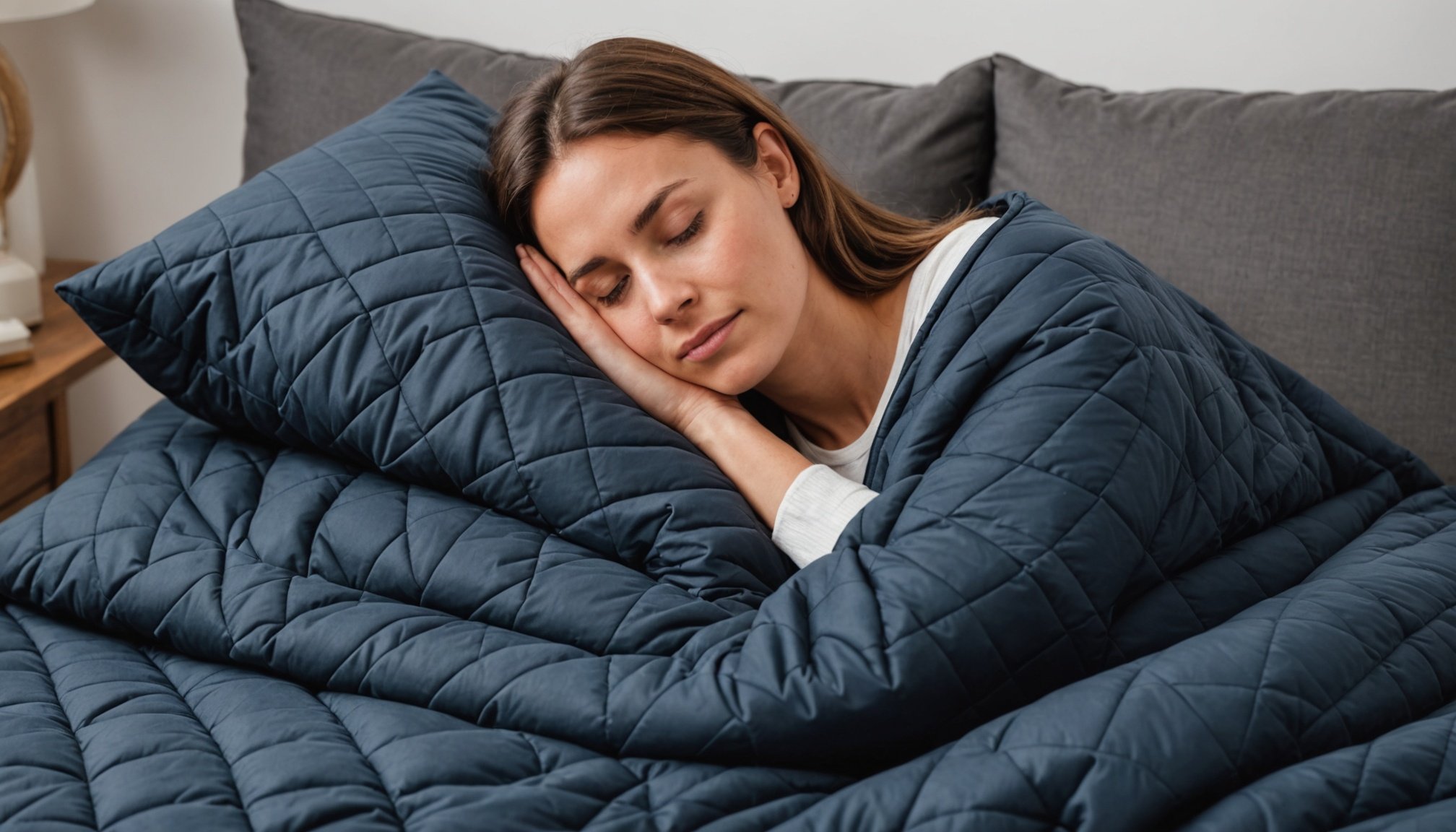Overview of Weighted Blankets
Weighted blankets are specially designed therapeutic tools filled with materials like glass beads or plastic pellets to add extra weight. Typically ranging from 5 to 30 pounds, these blankets distribute pressure evenly across the body. This pressure is akin to a technique known as deep pressure stimulation, said to mimic the feel of a comforting hug. Such stimulation is believed to aid anxiety relief and promote sleep improvement.
Historically, weighted blankets have roots in therapeutic settings, initially used by occupational therapists to assist patients with sensory processing disorders. Over the years, they have evolved from clinical tools into mainstream wellness products, increasingly recognised for their potential benefits in calming the nervous system.
Also to read : Unlocking the Advantages of a Low-Glycemic Diet for Those with Prediabetes: A Comprehensive Guide
In recent years, the popularity of weighted blankets has skyrocketed, aligning with broader trends in mental health support where individuals seek non-pharmaceutical aids. Users frequently report feelings of security and reduced anxiety levels, attributing these effects to improved sleep quality. As awareness around mental well-being increases, so too does the interest in natural aids like weighted blankets. Their continued rise in popularity underscores the growing public desire for solutions that offer both comfort and therapeutic benefits in everyday life.
How Weighted Blankets Alleviate Anxiety
Weighted blankets are gaining popularity for their remarkable calming effects. Fundamental to their efficacy is the mechanism of deep pressure stimulation. But how does this truly aid in reducing anxiety? Deep pressure on the body mimics a sensation akin to a gentle hug, activating the parasympathetic nervous system. This physiological response can significantly induce a calming effect, reducing stress levels.
This might interest you : Guidelines for Safely Incorporating Essential Oils at Home with Young Children
Research studies consistently back this mechanism, confirming that weighted blankets can assist in anxiety reduction. These studies provide compelling evidence, pointing out that individuals report decreased anxiety and improved sleep quality through the use of such blankets. The pressure seems to cause the release of neurotransmitters like serotonin, which contribute to emotional well-being and tranquility.
Real-life user testimonials further bolster these scientific findings. Many individuals have shared personal experiences, stating how weighted blankets offer them a sense of safety and comfort, much like a cocoon. These narratives align with the observed benefits, where users often speak of reduced tension and an overall enhanced quality of relaxation.
In conclusion, the combination of scientific backing and personal experiences highlights the profound benefits of weighted blankets for those seeking relief from anxiety. Their implementation could be a beneficial step towards a more peaceful state of mind.
Influence of Weighted Blankets on Sleep Quality
Weighted blankets are gaining popularity for their claims to enhance sleep quality. These blankets are believed to impact various sleep cycles, aiding individuals seeking insomnia solutions. Their usage has been associated with promoting restful sleep by inducing a calming effect on the body, thus potentially improving overall sleep quality.
Scientific studies highlight that weighted blankets can help regulate the body’s natural sleep cycles. By providing gentle pressure, they simulate a sense of being hugged, which can increase serotonin and melatonin levels—hormones that play a crucial role in restful sleep. This process is known as deep touch pressure stimulation and is linked to reduced anxiety and enhanced sleep quality.
Personal experiences further illustrate the benefits of weighted blankets. Many users report significant improvements, noting that the calming pressure helps them relax and fall asleep more swiftly. One user mentioned feeling as if they have a continuous comforting embrace throughout the night, leading to fewer interruptions in sleep cycles.
In conclusion, weighted blankets may serve as effective insomnia solutions by contributing to sleep quality enhancement. Their calming touch can offer individuals a reliable method to achieve that elusive restful sleep. Further research may continue to substantiate these claims and uncover additional benefits.
Choosing the Right Weighted Blanket
Selecting an appropriate weighted blanket can significantly enhance sleep quality by offering a calming, therapeutic experience. Understanding the factors involved is essential for making informed decisions.
Determining the Appropriate Weight
When selecting weighted blankets, one crucial factor is weight recommendation. Generally, it is suggested that a blanket should weigh roughly 10% of an individual’s body weight. This weight range helps maximize the blanket’s calming benefits while ensuring safety and comfort. For those between sizes, experts often advise opting for the lighter choice to avoid unnecessary pressure.
Material Choices for Comfort
Fabric options play a vital role in the comfort level of a weighted blanket. Materials such as cotton, fleece, or bamboo each provide distinct benefits. Cotton is praised for its breathability; fleece offers warmth, ideal for cooler environments, and bamboo excels in moisture-wicking, keeping the user cool. Evaluating these options helps determine the best fit for personal preferences and seasonal needs.
Size Considerations for Maximum Benefit
Finally, the size of the blanket is not just about covering the user but aligning with their height and usage preferences. A correctly sized blanket should drape comfortably without excess bulk while allowing for ease of movement. This ensures that the blanket’s weight is evenly distributed, delivering its calming effects throughout the night.
Using Weighted Blankets for Optimal Results
To truly benefit from weighted blankets, adopting the right bedtime routines is key. For optimal results, consider incorporating them into your nightly habit. Begin by setting a consistent sleep schedule around your use, ensuring you slide under your weighted blanket at the same time every night. This type of routine not only aids your body’s internal clock but also enhances the calming effects of the blanket.
Weighted blankets aren’t one-size-fits-all, and potential safety considerations should be taken into account, especially for children, the elderly, or individuals with certain health conditions. It’s essential to choose a blanket with an appropriate weight—typically around 10% of your body weight—to prevent discomfort or harm. Always consult with a healthcare provider if unsure about its usage.
Maintenance of your blanket is also crucial for its longevity and effectiveness. Follow these guidelines:
- Wash according to the manufacturer’s directions.
- Regularly check for any small damages.
- Store in a dry place to avoid moisture accumulation.
By integrating these best practices, you’ll ensure a seamless experience with your weighted blanket, improving both comfort and sleep quality.
Real-Life Case Studies and Testimonials
Understanding the effectiveness of weighted blankets requires insight into real user experiences and documented studies. Several users report significant anxiety relief and improved sleep quality, enabled by the calming effect of weighted blankets. In particular, one case study involved adults suffering from generalised anxiety disorder (GAD), highlighting remarkable reduction in anxiety symptoms after consistent use.
Mental health professionals often endorse weighted blankets as beneficial tools. A therapist noted that these blankets aid in self-soothing, mirroring therapeutic touch which comforts the nervous system. They are particularly praised for their utility in insomnia management among anxiety-prone individuals.
User feedback spans a wide demographic range, from young adults grappling with exam stress to elderly users seeking better sleep. For instance, a university student shared that the blanket alleviated pre-exam jitters, while an elderly user found it reduced nighttime awakenings. Notably, a study of children with autism indicated reduced anxiety and better focus during demanding tasks.
Reviews acknowledge variability in individual experiences, underscoring that while some view the blankets as transformative, others might experience mild or delayed outcomes. Overall, these case studies and testimonials build a compelling narrative on the therapeutic potential of weighted blankets across diverse demographics.
Expert Opinions on Weighted Blankets
Weighted blankets have garnered attention not just from the general public but from mental health professionals as well. Expert insights often reveal the advantages and limitations of these comforting tools. In their interviews, psychologists frequently discuss how the gentle pressure from weighted blankets mimics deep pressure stimulation, which can alleviate stress and anxiety.
Sleep therapists often recommend weighted blankets as part of a holistic approach to improving sleep quality. They highlight studies that associate these blankets with increased serotonin levels, enhancing mood and promoting relaxation. However, experts also caution against their use for individuals with specific medical conditions, such as respiratory issues, without consulting a healthcare provider.
Incorporating weighted blankets into therapy can be beneficial, but it requires careful consideration. Professional recommendations suggest starting with a blanket that is about 10% of the user’s body weight and gradually increasing exposure time to avoid discomfort.
For those considering integrating weighted blankets as a therapeutic tool, experts advise discussing this with a healthcare professional to tailor its use to individual needs and ensure its effectiveness. Following expert guidance ensures the safe and beneficial use of weighted blankets in mental health and well-being practices.
Conclusion and Future Implications
The future of weighted blankets promises intriguing emerging trends and innovations in their design. Manufacturers are increasingly focusing on integrating technology, such as smart fabrics that adjust weight based on body temperature and movements. This could revolutionise the comfort and effectiveness of weighted blankets.
As the popularity of these blankets grows, ongoing research continues to explore their benefits. Studies are investigating the impact of weighted blankets beyond anxiety and sleep disorders, considering their potential utility in broader mental health contexts. Such research promises to open new avenues for therapeutic applications.
Awareness plays a critical role in the accessibility of these tools. Increasing public understanding of the benefits provided by weighted blankets can lead to better mental health outcomes. Society should advocate for equitable access to these resources, ensuring everyone can benefit, regardless of economic status.
In light of these developments, it’s essential to stay informed about advancements in weighted blankets. Staying aware can guide individuals in making informed decisions about their mental health and comfort needs. Together, continued innovation and research, coupled with heightened awareness, will shape the trajectory of these beneficial tools, making them an integral part of many people’s lives.











